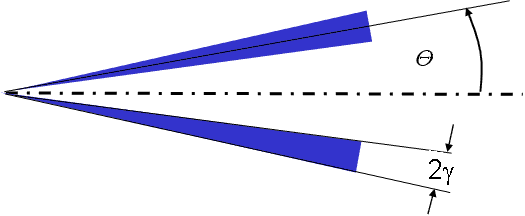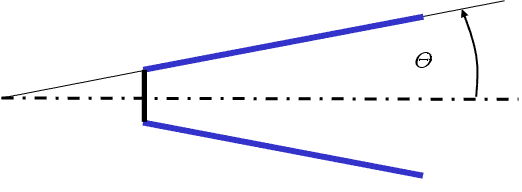When creating a cone, a cone may describe the shape of the particle tracks. The particles actually enter from a 2D region, which may be a point, a circle, or an annular region according to the Cone Definition parameters. The orientation of this plane is determined by the injection direction. Note that the direction in which the particles enter may or may not be independent of the orientation of the 2D region.
The following cone injection types are supported in CFX-Pre:
Point Cone
Hollow Cone
Ring Cone
Full Cone
The injection center, injection velocity, injection direction, number of positions, and cone definition are required for setting up various cone injection types. An optional Dispersion Angle of the spray can be specified for point and hollow cone types by setting one of the following parameters:
Dispersion Angle: The specified value is considered to be a ‘half angle’ similar to the spray cone angle definition.Standard Deviation of Dispersion Angle: The specified value is considered as a normal distribution of the spray within the dispersion angle.
The injection velocity can be set via the specification of the Velocity Magnitude, Cartesian Velocity Components, Cylindrical Velocity Components, or Zero Slip Velocity. The Zero Slip Velocity option causes the particles to be injected at the local fluid velocity of the coupled continuous phase.
Note that the specification of Cylindrical Velocity Components is not supported for Point Cones.
To simplify the specification of swirl for the injection velocity a new particle variable <Particle Type>.Particle Position was introduced. The components of this variable hold the x, y, and z distance from the local injector center and can be used in CEL to define swirl components for the particle injection velocity vector.
Velocities for particles are always assumed to be specified in the absolute frame.
The following illustration shows a point cone with cone angle of 45 degrees. The injection direction is specified normal to the injection boundary. As the Cone Definition parameter for point cone does not require the specification of inner and outer radii, the particles are injected from a point at the injection center.

This following illustration shows how the optionally specified dispersion
angle, , changes the injection type from
point cone (Figure 8.4: Point cone with specified cone angle) to point
hollow cone (Figure 8.5: Point cone with specified cone angle and dispersion angle). The cone
angle is shown as
.
This following illustration shows how the optionally specified dispersion
angle, , changes the spray pattern in the
case of a hollow cone injection. The cone angle is shown as
.






